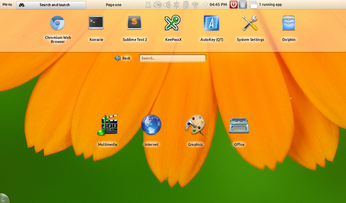KDE Plasma Netbook Revisited

Productivity Sauce
With Unity, Cinnamon, and Gnome 3 getting all the buzz, it's easy to overlook other interesting projects that attempt to rethink the traditional desktop metaphor. Case in point, the KDE Plasma Netbook interface. Despite its moniker, the KDE's alternative interface is not limited to netbooks, although it's designed for devices with small screens. KDE's alternative interface has been around for a while, but I only recently started using it as a primary environment on my trusty ASUS Eee PC 1005HA netbook, and I grew fond of it for a number of reasons.
For starters, KDE Plasma Netbook is surprisingly snappy. Even on my 3-year-old underpowered netbook, the interface is responsive enough for daily use. More importantly, it offers several customization options which can be used to configure the environment to your specific needs. KDE Plasma Netbook replaces the regular desktop with so-called pages of different types. By default, the interface has two pages: Search and Launch and Page One. The former provides quick access to all installed applications, while the latter uses the newspaper layout that can be populated with your favorite widgets. You can, of course, add other pages, if needed. To do this, click on the Plasma logo (Cashew) at the bottom of the page and click on Add Page in the configuration bar. In addition to the Search and Launch and Newspaper Layout, the system offers two other page types: Folder View that displays the contents of a specific folder and Desktop that acts as a regular desktop. This ability to add multiple pages of different types gives you a lot of flexibility when it comes to customizing your computing environment.
KDE 4 also makes it easy to switch between the netbook and regular desktop interfaces. So you can use the netbook interface when you are out and about, and then switch to the full-blown desktop when you connect an external display to your machine. To switch between interfaces, go to System Settings | Workspace Behavior | Workspace and pick the desired interface from the Workspace Type drop-down list.
All of this, as well as a slew of other nifty features, makes KDE Plasma Netbook a viable alternative to existing graphical desktop environments. So whether you want to give your old netbook a new lease of life, or you're thinking about trying something different, KDE Plasma Netbook definitely deserves a closer look.
Comments
comments powered by DisqusSubscribe to our Linux Newsletters
Find Linux and Open Source Jobs
Subscribe to our ADMIN Newsletters
Support Our Work
Linux Magazine content is made possible with support from readers like you. Please consider contributing when you’ve found an article to be beneficial.

News
-
Parrot OS Switches to KDE Plasma Desktop
Yet another distro is making the move to the KDE Plasma desktop.
-
TUXEDO Announces Gemini 17
TUXEDO Computers has released the fourth generation of its Gemini laptop with plenty of updates.
-
Two New Distros Adopt Enlightenment
MX Moksha and AV Linux 25 join ranks with Bodhi Linux and embrace the Enlightenment desktop.
-
Solus Linux 4.8 Removes Python 2
Solus Linux 4.8 has been released with the latest Linux kernel, updated desktops, and a key removal.
-
Zorin OS 18 Hits over a Million Downloads
If you doubt Linux isn't gaining popularity, you only have to look at Zorin OS's download numbers.
-
TUXEDO Computers Scraps Snapdragon X1E-Based Laptop
Due to issues with a Snapdragon CPU, TUXEDO Computers has cancelled its plans to release a laptop based on this elite hardware.
-
Debian Unleashes Debian Libre Live
Debian Libre Live keeps your machine free of proprietary software.
-
Valve Announces Pending Release of Steam Machine
Shout it to the heavens: Steam Machine, powered by Linux, is set to arrive in 2026.
-
Happy Birthday, ADMIN Magazine!
ADMIN is celebrating its 15th anniversary with issue #90.
-
Another Linux Malware Discovered
Russian hackers use Hyper-V to hide malware within Linux virtual machines.


one desktop, many looks, many uses, many computing devices
I dont use my desktop like I do my laptop or 9inch netbook.
I like being able to switch from netbook to full OS.
heck, my wife only uses it in Netbook mode on her 14inch laptop and shes happy with that.
After seeing videos of the KDE Plasma UI for tablets like the Vivaldi, they have taken that idea to another paradigm.
Id wish programs also offered this choice to have full featured UI or just a beginner-newbie one that would only offer the most used features with an option to change to a full service look at one click of button.
Not only for netbooks
The KDE guys have also improved it's customization and configurability over the past versions. The good thing is that it's easy to use and the search function makes everything so much easier. One saves a lot of clicks and time using this desktop.al
how is this different from the search and launch activity
These Pages in the Netbook interface seem like Activities in the regular interface
How do they differ?
you are right
much to my surpise that it was very usable. It really is
an alternative interface for larger computers.
Praize
It's great and I use on my HTPC because of clean looks and easy navigation on a big screen.